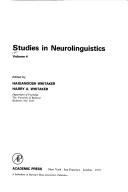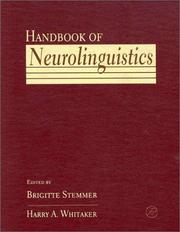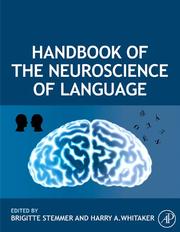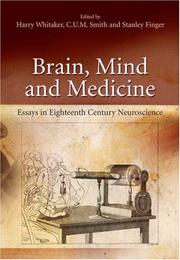
ISBN: 0127463046 0127463011 012746302X 0127463038 0127453038 1483220567 132246054X 1483265404 9780127463018 9780127463025 9780127463032 9780127463049 Year: 1979 Publisher: New York (N.Y.): Academic press,
Abstract | Keywords | Export | Availability | Bookmark
 Loading...
Loading...Choose an application
- Reference Manager
- EndNote
- RefWorks (Direct export to RefWorks)
800:159.9 --- 800:159.9 Taalwetenschap. Taalkunde. Linguistiek-:-Psychologie: zie ook: Psychiatrie: n-{616.89-008} en n-{615.851} --- Taalwetenschap. Taalkunde. Linguistiek-:-Psychologie: zie ook: Psychiatrie: n-{616.89-008} en n-{615.851} --- Speech disorders --- Defective speech --- Disorders of speech --- Speech, Disorders of --- Speech defects --- Speech pathology --- Neurolinguistics. --- Speech disorders. --- Neurophysiology. --- Neurophysiology --- Neurolinguistics --- Neurolinguistique --- Troubles de la parole --- Language. --- Communicative disorders --- Neuropathology --- Psycholinguistics
Book
Year: 1976 Publisher: New York (N.Y.) Academic Press
Abstract | Keywords | Export | Availability | Bookmark
 Loading...
Loading...Choose an application
- Reference Manager
- EndNote
- RefWorks (Direct export to RefWorks)

ISBN: 0126660557 9780126660555 9780080533131 0080533132 1281057096 9781281057099 Year: 1998 Publisher: San Diego, Calif. Academic Press
Abstract | Keywords | Export | Availability | Bookmark
 Loading...
Loading...Choose an application
- Reference Manager
- EndNote
- RefWorks (Direct export to RefWorks)
The Handbook of Neurolinguistics is a state-of-the-art reference and resource book; it describes current research and theory in the many subfields of neurolinguistics and its clinical application. Thorough and clearly written, the Handbook provides an excellent overview of the field of neurolinguistics and its development. The book is organized into five parts covering the history of neurolinguistics, methods in clinical and experimental neurolinguistics, experimental neurolinguistics, clinical neurolinguistics, and resources in neurolinguistics. The first four parts contain a wide range of topics which discuss all important aspects of the many subfields of neurolinguistics. Also included are the relatively new and fast developing areas of research in discourse, pragmatics, and recent neuroimaging techniques. The resources section provides currently available resources, both traditional and modern. The Handbook is useful to the newcomer to the field, as well as the expert searching for the latest developments in neurolinguistics. Key Features * Clearly written and well organized * Provides extensive resources * Discusses both history and current research * Covers the many subfields of neurolinguistics as well the developing areas of research.

ISBN: 9780080453521 008045352X Year: 2008 Publisher: Amsterdam Elsevier
Abstract | Keywords | Export | Availability | Bookmark
 Loading...
Loading...Choose an application
- Reference Manager
- EndNote
- RefWorks (Direct export to RefWorks)
In the last ten years the neuroscience of language has matured as a field. Ten years ago, neuroimaging was just being explored for neurolinguistic questions, whereas today it constitutes a routine component. At the same time there have been significant developments in linguistic and psychological theory that speak to the neuroscience of language. This book consolidates those advances into a single reference. The Handbook of the Neuroscience of Language provides a comprehensive overview of this field. Divided into five sections, section one discusses methods and techniques including clinical assessment approaches, methods of mapping the human brain, and a theoretical framework for interpreting the multiple levels of neural organization that contribute to language comprehension. Section two discusses the impact imaging techniques (PET, fMRI, ERPs, electrical stimulation of language cortex, TMS) have made to language research. Section three discusses experimental approaches to the field, including disorders at different language levels in reading as well as writing and number processing. Additionally, chapters here present computational models, discuss the role of mirror systems for language, and cover brain lateralization with respect to language. Part four focuses on language in special populations, in various disease processes, and in developmental disorders. The book ends with a listing of resources in the neuroscience of language and a glossary of items and concepts to help the novice become acquainted with the field. Editors Stemmer & Whitaker prepared this book to reflect recent developments in neurolinguistics, moving the book squarely into the cognitive neuroscience of language and capturing the developments in the field over the past 7 years. * History section focuses on topics that play a current role in neurolinguistics research, aphasia syndromes, and lesion analysis * Includes section on neuroimaging to reflect the dramatic changes in methodology over the past decade * Experimental and clinical section reflects recent developments in the field.
Book
Year: 1976 Publisher: New York, San Francisco, London Academic Press
Abstract | Keywords | Export | Availability | Bookmark
 Loading...
Loading...Choose an application
- Reference Manager
- EndNote
- RefWorks (Direct export to RefWorks)
Book
ISBN: 9401787743 9401787735 Year: 2014 Publisher: Dordrecht : Springer Netherlands : Imprint: Springer,
Abstract | Keywords | Export | Availability | Bookmark
 Loading...
Loading...Choose an application
- Reference Manager
- EndNote
- RefWorks (Direct export to RefWorks)
This volume of essays examines the problem of mind, looking at how the problem has appeared to neuroscientists (in the widest sense) from classical antiquity through to contemporary times. Beginning with a look at ventricular neuropsychology in antiquity, this book goes on to look at Spinozan ideas on the links between mind and body, Thomas Willis and the foundation of Neurology, Hooke’s mechanical model of the mind and Joseph Priestley’s approach to the mind-body problem. The volume offers a chapter on the 19th century Ottoman perspective on western thinking. Further chapters trace the work of nineteenth century scholars including George Henry Lewes, Herbert Spencer and Emil du Bois-Reymond. The book covers significant work from the twentieth century, including an examination of Alfred North Whitehead and the history of consciousness, and particular attention is given to the development of quantum consciousness. Chapters on slavery and the self and the development of an understanding of Dualism bring this examination up to date on the latest 21st century work in the field. At the heart of this book is the matter of how we define the problem of consciousness itself: has there been any progress in our understanding of the working of mind and brain? This work at the interface between science and the humanities will appeal to experts from across many fields who wish to develop their understanding of the problem of consciousness, including scholars of Neuroscience, Behavioural Science and the History of Science.
Neurosciences --- Neuropsychology --- History. --- Philosophy. --- Biology-Philosophy. --- Psychology, clinical. --- Neurobiology. --- Philosophy of Biology. --- Neuropsychology. --- Biology—Philosophy. --- Neurophysiology --- Psychophysiology --- Biology --- Neurosciences. --- Neuroscience. --- Neural sciences --- Neurological sciences --- Neuroscience --- Medical sciences --- Nervous system --- Vitalism
Digital
ISBN: 9789401787741 Year: 2014 Publisher: Dordrecht Springer Netherlands
Abstract | Keywords | Export | Availability | Bookmark
 Loading...
Loading...Choose an application
- Reference Manager
- EndNote
- RefWorks (Direct export to RefWorks)
This volume of essays examines the problem of mind, looking at how the problem has appeared to neuroscientists (in the widest sense) from classical antiquity through to contemporary times. Beginning with a look at ventricular neuropsychology in antiquity, this book goes on to look at Spinozan ideas on the links between mind and body, Thomas Willis and the foundation of Neurology, Hooke’s mechanical model of the mind and Joseph Priestley’s approach to the mind-body problem. The volume offers a chapter on the 19th century Ottoman perspective on western thinking. Further chapters trace the work of nineteenth century scholars including George Henry Lewes, Herbert Spencer and Emil du Bois-Reymond. The book covers significant work from the twentieth century, including an examination of Alfred North Whitehead and the history of consciousness, and particular attention is given to the development of quantum consciousness. Chapters on slavery and the self and the development of an understanding of Dualism bring this examination up to date on the latest 21st century work in the field. At the heart of this book is the matter of how we define the problem of consciousness itself: has there been any progress in our understanding of the working of mind and brain? This work at the interface between science and the humanities will appeal to experts from across many fields who wish to develop their understanding of the problem of consciousness, including scholars of Neuroscience, Behavioural Science and the History of Science.
Philosophy --- Psychology --- Biology --- Biological anthropology. Palaeoanthropology --- Physiology of nerves and sense organs --- Psychiatry --- Neuropathology --- medische psychologie --- biologie --- filosofie --- neuropsychologie --- neurobiologie

ISBN: 1281116041 9786611116040 0387709673 0387709665 1441943684 Year: 2007 Publisher: New York : Springer,
Abstract | Keywords | Export | Availability | Bookmark
 Loading...
Loading...Choose an application
- Reference Manager
- EndNote
- RefWorks (Direct export to RefWorks)
Ideas we associate with the 18th century are clearly seen in work published from the latter decades of the 17th century through the first decades of the 19th century. This is the "long 18th century", a period which exhibits multiple discourses in medicine, brain science and philosophy. The editors have deliberately adopted a "presentist" subtitle, "neuroscience", to emphasize that this collection of essays reflect a range of current thought about 18th century-studies of the nervous system in isolation and in context. There are six sections, each preceded by a short introduction. The opening section of Brain, Mind and Medicine: Neuroscience in the 18th Century sets forth a temporal chronology for the long 18th century. This is followed by a background section of essays on (a) brain and mind in the long 18th century, (b) the role of microscopes and microscopy in this period, (c) the nature of 18th century medical education and the place of voluntary hospitals and (d) an illustration of late-18th century medicine, discussing the early career of James Parkinson as an example. The third section contains a series of papers focusing on the nervous system, with (a) an exegesis of John Hunter’s work, (b) the contributions of William Cullen and Robert Whytt, (c) a detailed analysis of the physiological and anatomical work of Pourfour du Petit, (d) the debate between Albrecht Haller and Robert Whytt concerning the mechanism of muscle contraction and two essays on developments in animal electricity during this epoch, (e) the early history starting with observations of the electric ray, and (f) the later contributions of Luigi Galvani, medical man and scientist. The fourth section on brain and behavior considers (a) William Porterfield’s thoughts on vision, and three essays in speculative philosophy of neuroscience, (b) a discussion of David Hartley’s vibration theory, (c) a discussion of Charles Bonnet’s vibration theory and an analysis of Emanuel Swedenborg’s century-too-soon thoughts on localization of brain function. The next section opens with an essay (a) on the neuroscientific ideas of Hermann Boerhaave and Albrecht Haller, then (b) a discussion of the evolution of our understanding of strokes in this epoch; these are followed by three essays on the development and applications of medical electricity, the first (c) on the contribution of Benjamin Franklin, the second (d) on how medical electricity was discussed in the popular publication, Gentleman’s Magazine, and the third (e) on the application of medical electricity in physician’s practices. The essays continue with (f) the medical opinions of the clergyman John Wesley, followed by (g) an essay on the best example of the power of suggestion in this era, Franz Anton Mesmer’s notions of animal magnetism. The final essay in this section (h) discusses the evolution of the concept of hysteria well in advance of the well-known work of Jean Marie Charcot and Sigmund Freud. The final three essays in the last section capture some of the cultural consequences of 18th century interest in the nervous system: (a) in the context of French materialism, (b) in Jonathan Swift’s literary treatment of brain and nervous system and, finally (c) in an analysis of the origin and development of the concept of temperament. Cover illustration: A young woman being treated with medical electricity in the 18th century. (From Adams, 1785; see chapter by Bertucci.).
Neurosciences --- History --- Neural sciences --- Neurological sciences --- Neuroscience --- Medical sciences --- Nervous system --- Neurosciences. --- History. --- Medicine. --- History of Science. --- History of Medicine. --- Clinical sciences --- Medical profession --- Human biology --- Life sciences --- Pathology --- Physicians --- Annals --- Auxiliary sciences of history --- Health Workforce --- Medicine—History.
Book
ISBN: 9024729092 9400969317 9400969295 Year: 1984 Volume: 18 Publisher: The Hague Boston Lancaster Martinus Nijhoff Publishers
Abstract | Keywords | Export | Availability | Bookmark
 Loading...
Loading...Choose an application
- Reference Manager
- EndNote
- RefWorks (Direct export to RefWorks)
Dyslexia --- Dyslexie --- Congresses --- Congrès
Digital
ISBN: 9780387709673 Year: 2007 Publisher: Boston, MA Springer Science+Business Media, LLC
Abstract | Keywords | Export | Availability | Bookmark
 Loading...
Loading...Choose an application
- Reference Manager
- EndNote
- RefWorks (Direct export to RefWorks)
Pure sciences. Natural sciences (general) --- History of human medicine --- Neuropathology --- wetenschapsgeschiedenis --- neurologie --- geneeskunde --- geschiedenis

 Search
Search Feedback
Feedback About UniCat
About UniCat  Help
Help News
News